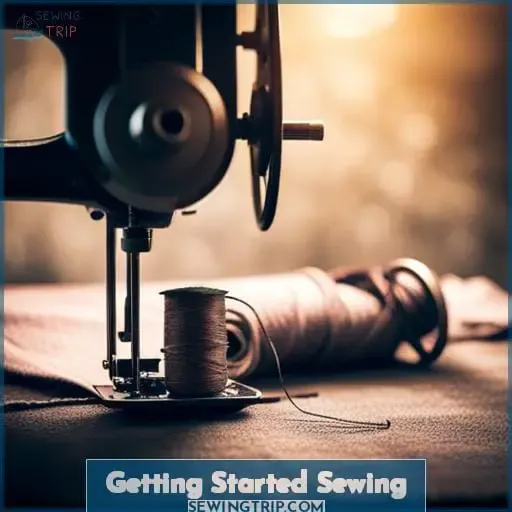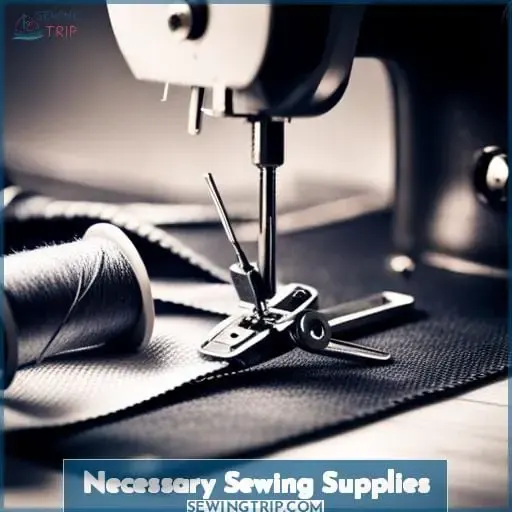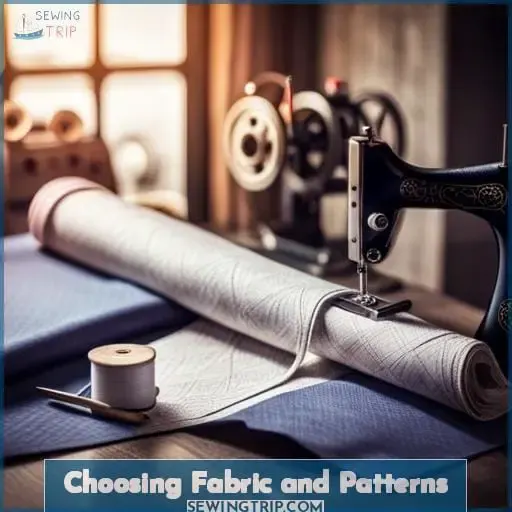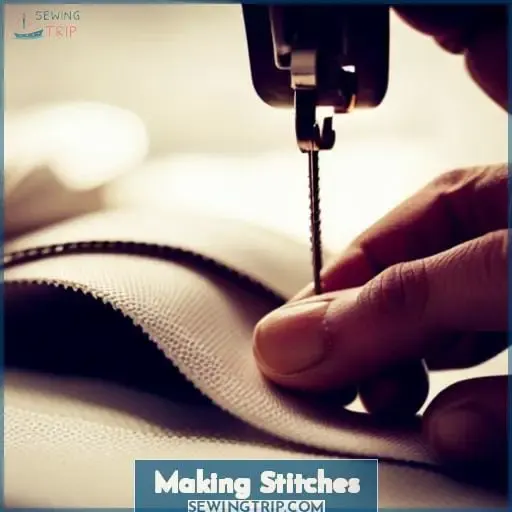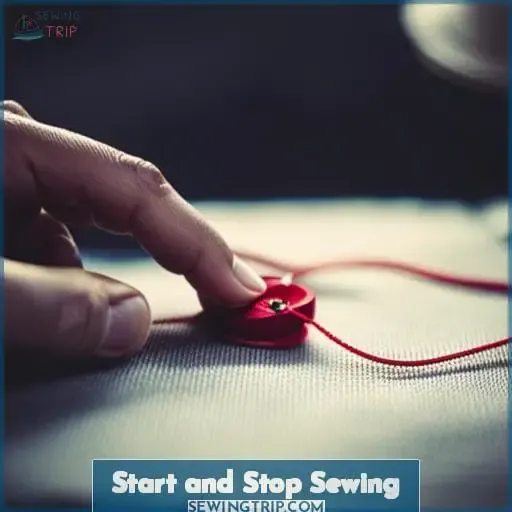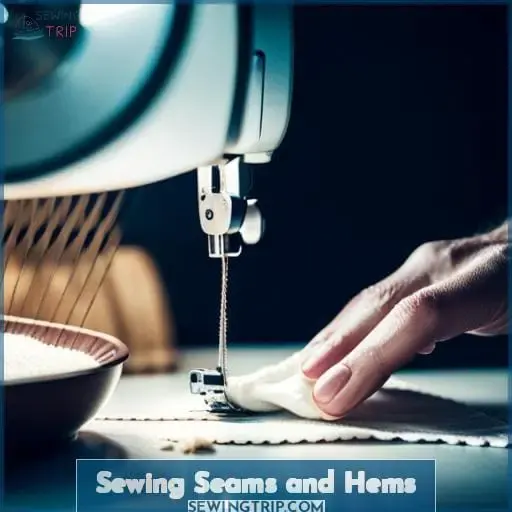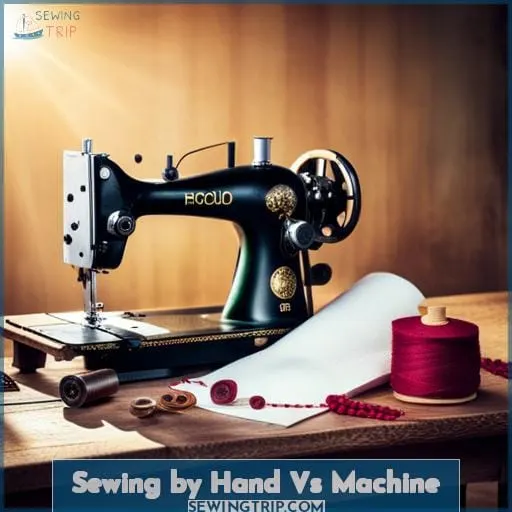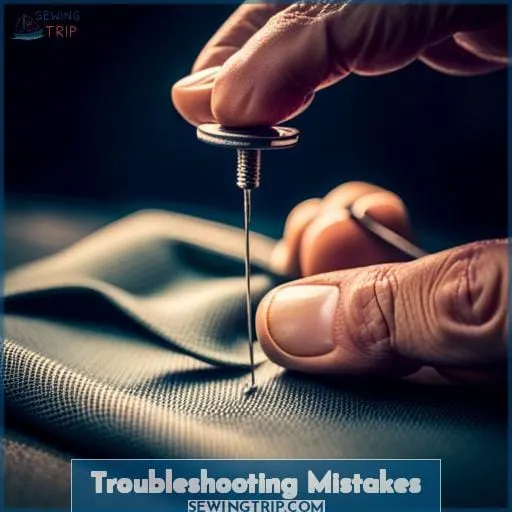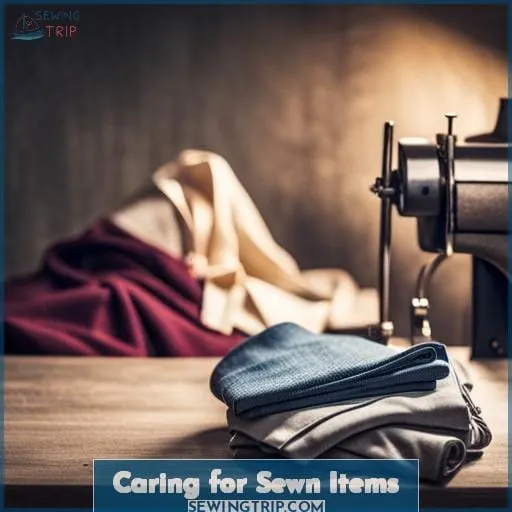This site is supported by our readers. We may earn a commission, at no cost to you, if you purchase through links.
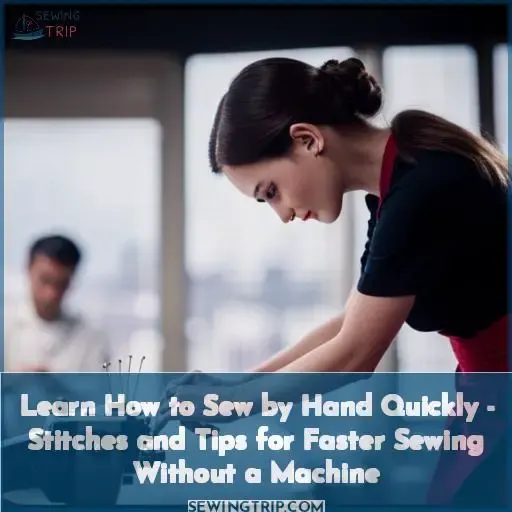 Needle poised, thread pulled taut – the joy of hand sewing awaits. We’ll be stitching up skills in no time with tested tricks for faster fabrication. From prepping materials to mastering basic seams, this guide threads you through essential techniques so you can liberation your inner innovation.
Needle poised, thread pulled taut – the joy of hand sewing awaits. We’ll be stitching up skills in no time with tested tricks for faster fabrication. From prepping materials to mastering basic seams, this guide threads you through essential techniques so you can liberation your inner innovation.
Ready, set, sew!
Table Of Contents
Key Takeaways
- Choose the appropriate sewing supplies and fabric for your project.
- Master the different stitches and techniques to achieve desired outcomes.
- Pay attention to details such as tension, straightness, and finishing edges.
- Consider the advantages and disadvantages of hand sewing vs machine sewing.
Getting Started Sewing
First, gather all the necessary supplies and materials to begin sewing by hand.
You’ll need:
- Fabric
- Thread
- Hand sewing needles
- Scissors
- Other notions like pins or clips
Choose your fabric type and weight according to your project – cottons and linens in light to medium weights are good for beginners.
Select all-purpose polyester or cotton threads; avoid anything too heavy or textured.
Hand sewing needles come in a range of sizes – try between a size 5-10 sharps or crewel needle to start.
Have scissors on hand that can cut fabric cleanly.
Spread out your materials and get your hands ready for making stitches!
With some preparatory gathering of essential hand sewing supplies, you’ll be equipped to start stitching fabrics together creatively. Assembling materials is the first step before diving into executing different types of seams, hems, and other techniques.
Necessary Sewing Supplies
When gathering your sewing supplies, you’ll be needing:
- Thread
- Needles
- Scissors
- Straight pins
- A thimble
- Seam ripper
- Measuring tools
For basic hand sewing projects, choose all-purpose polyester or cotton threads for most fabrics. Match lightweight threads like 60wt to lighter fabrics, or heavier 30wt threads for denim and canvas.
Hand sewing and embroidery needles should be sharp, sized to your thread and fabric weight.
Have an iron and small ironing board handy to press seams. Stock up on fabric like cotton wovens, linen, knits – prewash before sewing.
Notions like zippers, interfacing, elastic will be essential too.
Beyond materials, you need space, light and organization. Set up near a window on a sturdy table.
Having the right sewing gear will make learning stitches and sewing techniques satisfying. Approach your project with quality tools fitting the fabric and task at hand. Then let creativity flow as you master hand sewing pieces together.
Choosing Fabric and Patterns
When it comes to choosing fabric for your hand-sewing projects, there are a few key points to consider:
First, pay attention to the weave weight of the fabric. Lighter fabrics like cotton and linen are easier to work with when sewing by hand.
Additionally, make sure you match the pattern style of your fabric with your desired project outcome.
Lastly, always pre-wash your fabric before sewing in order to control shrinkage and ensure that your finished piece maintains its size and shape.
Pick Fabric Weave Weight
Why is it important to consider the fabric weave weight when choosing fabric and patterns for hand sewing?
It’s crucial because different weights of fabrics have distinct characteristics that can affect your sewing experience.
- Light weight, drapey fabrics are ideal for flowy garments.
- Medium weight, durable fabrics work well for everyday wear.
- Heavyweight, sturdy fabrics are great for structured pieces.
- Knit fabrics offer stretch and comfort while woven fabrics provide stability.
Match Fabric Pattern Style
To match your fabric pattern style, consider the design and motif as you choose materials for hand sewing.
Use similar colors, textures, shapes, and sizes to create a cohesive look.
Avoid clashing patterns that may distract from the overall aesthetic of your project.
Whether you’re making a tiny circle purse or adding piping with bias binding, selecting fabrics that complement each other will elevate your handmade creations with style and flair.
Pre-Wash Shrinkage Control
Before getting into stitches, you’ll want to pre-wash your fabric and patterns prior to cutting and sewing to prevent shrinkage from ruining your finished item down the road.
Immerse the materials in lukewarm water, using a gentle detergent, then lay flat or tumble dry on low.
This pre-shrinking allows the fabric to relax before being cut and formed. With shapes and sizes stabilized, your creation will hold its structure during construction and first washes.
Making Stitches
When making stitches by hand, you’ll use some essential techniques like the straight stitch and zigzag stitch. These two stitches form the foundation for hand sewing and once mastered, you can use them to sew all sorts of fabrics and items.
Now let’s dive into the specifics of executing these fundamental stitches.
Straight Stitch
How’d you sew a basic straight stitch by hand after choosin’ your fabric and patterns? Keep stitches straight by sewin’ slowly and usin’ a thimble to push the needle through.
- Focus on keepin’ tension even
- Use a hoop or frame to keep fabric taut
- Pierce the fabric at regular intervals
- Pull each stitch snug, but not too tight
Hand sewin’ allows great control for precision work. Masterin’ basic stitches unlocks your creativity to craft custom pieces.
Zigzag Stitch
After making straight stitches, create texture by zigzagging your needle diagonally through the fabric about 1⁄4 inch apart.
This zigzag stitch uses two needles and creates a zigzag line as you weave the thread in and out.
The zigzag stitch is also used for decorative purposes like embroidery. And it creates stretchy seams that move with knits and bias-cut fabrics.
Alter your stitch length and width for different looks. A tight zigzag finishes edges smoothly while a wide stitch makes a bold decorative statement.
Start and Stop Sewing
To start and stop sewing by hand, simply tie a knot at the end of your thread before beginning to sew, and tie another knot when you’re finished. This ensures that your stitches stay in place and prevents them from unraveling.
Here are three simple steps to follow when starting and stopping your hand-sewn projects:
- Push the needle through the fabric: After tying a knot at the end of your thread, push the needle through the fabric where you want to begin sewing.
- Pull the thread all the way through: Once you have pushed the needle through, pull on it gently until it’s fully threaded.
- Tie a final knot and cut off excess thread: When you reach your desired stopping point or complete stitching along a seam line, tie another secure knot in your thread close to where it emerges from underneath the fabric surface. Cut off any excess thread.
Sewing Seams and Hems
You’ll sew seams and hems to join fabric pieces and finish edges.
To sew a basic seam, align fabric edges and pin or baste together. Then sew using small, even straight or zigzag stitches about 1⁄4-inch from the raw edge. For added strength, stitch seams twice, sewing first at 1⁄4-inch then again at 1⁄8-inch.
When hemming, turn under the raw edge twice to encase it inside clean folded fabric. Hemming hides fraying edges with a neat finish. Use a straight stitch for sturdy hems or nearly invisible slip stitch to neatly secure.
For lightweight or stretchy fabrics try narrow machine hemming or a lettuce edge.
When hand sewing, take care not to pull threads too tightly or pucker seams. Adjust length and tension of stitches for best results with each fabric.
Compare techniques like french seams encasing raw edges inside, whipstitching appliques, herringbone stitching hems, and blanket stitch finishing fabric edges.
Sewing by Hand Vs Machine
When sewing by hand, you have the advantage of being able to control every stitch and detail, unlike using a machine. Hand sewing allows for greater precision and mastery over your work. You can easily adjust the tension of each stitch and make fine adjustments as needed.
This level of control is especially beneficial when working with delicate fabrics or intricate designs.
Another benefit of hand sewing is that it allows for more flexibility in terms of speed. While a machine may be faster overall, hand sewing gives you the freedom to sew at your own pace without feeling rushed.
It also provides an opportunity to practice patience and mindfulness as you focus on each individual stitch.
However, it’s important to acknowledge that hand sewing does have its disadvantages too. It can be more time-consuming compared to using a machine, particularly when working on larger projects or repetitive tasks like hemming multiple garments.
In summary, while there are advantages and disadvantages to both methods, incorporating some amount of hand stitching into your practice can offer unique benefits such as increased control over details and the ability to sew at your preferred speed.
Troubleshooting Mistakes
Although sewing by hand or machine both have their uses, errors will happen when you’re learning and can be fixed if you know what to look for.
To prevent puckering, ensure the tension on your thread isn’t too tight as you sew.
For uneven stitches, practice keeping your stitch length consistent – use stitching lines on sewing patterns as a guide.
If knots appear in your thread as you sew, trim them close to the fabric using sharp scissors.
For crooked seams, frequently pin the fabric pieces together while sewing to keep the edges aligned.
Finally, neaten up loose dangling threads right away with a needle to prevent unraveling.
Stay observant, patient, and dedicated to precision as you learn. With some thoughtful troubleshooting, you’ll be sewing creations to admire in no time.
Caring for Sewn Items
Now that you’ve learned how to sew by hand and have completed your sewing projects, it’s important to know how to properly care for your newly sewn items. Taking care of your creations will ensure their longevity and keep them looking beautiful.
- Hand wash: To preserve the integrity of the stitches, it’s best to hand wash delicate fabrics or those with intricate details.
- Lay flat to dry: Avoid using a dryer as it can damage the fabric and distort the shape of your garment or item. Instead, lay it flat on a clean surface until completely dry.
- Spot clean: For small stains or spills, spot cleaning is often sufficient instead of subjecting the entire piece to washing.
- Use dry cleaner when necessary: If you’re dealing with more stubborn stains or if an item specifically recommends professional cleaning only.
Remember these additional guidelines:
- Iron inside out at low heat
- Hang-dry in a well-ventilated area away from direct sunlight
- Store flat in a cool place away from moisture
By following these simple yet crucial steps, you’ll be able to enjoy wearing and using your handmade treasures for years to come!
Frequently Asked Questions (FAQs)
How do I choose the right needle size for my fabric?
To choose the right needle size, match the needle size to your fabric weight.
A too large needle will leave big holes, while a too small needle risks bending or breaking.
Test with sample fabrics to see which needle glides smoothly without damaging material.
Generally:
- lightweight fabrics take size 9-11 needles
- medium take size 12-14
- heavier fabrics size 16 or higher.
What is the best type of thread to use for sewing?
When it comes to choosing the best thread for sewing, opt for a strong and durable one that matches your fabric.
A high-quality thread will ensure your stitches hold up under pressure.
Can I sew without a sewing machine?
Yes, you can absolutely sew without a sewing machine!
With some basic materials like thread, needle, and fabric, you can embrace the art of hand sewing and create beautiful garments or crafts.
How do I fix a skipped stitch on my sewing machine?
Is your machine skipping stitches?
Check the tension first.
Make sure the top thread is pulled tightly through the fabric.
If needed, tighten thread tension knob, or rethread top and bobbin completely.
Finally, change the needle. A slightly bent or dull needle could be the culprit.
How do I properly finish the edges of my fabric?
Fold over fabric edge 1/4-inch twice.
Stitch along inner folded edge using zigzag stitch pattern.
Trim excess edge with pinking shears.
Check neatness of stitching on fabric front and back.
Finish visible raw edges this way for a clean, professional look.
Conclusion
Master the art of quick sewing by hand with these essential tips and techniques.
With the right supplies and fabric choices, you can easily create beautiful stitches and hems.
Whether you prefer a straight stitch or a zigzag stitch, this guide has got you covered.
Learn how to start and stop sewing with ease, and discover the advantages of sewing by hand versus using a machine.
Troubleshoot mistakes and keep your sewn items looking their best with proper care.
Start sewing quickly and efficiently today!

